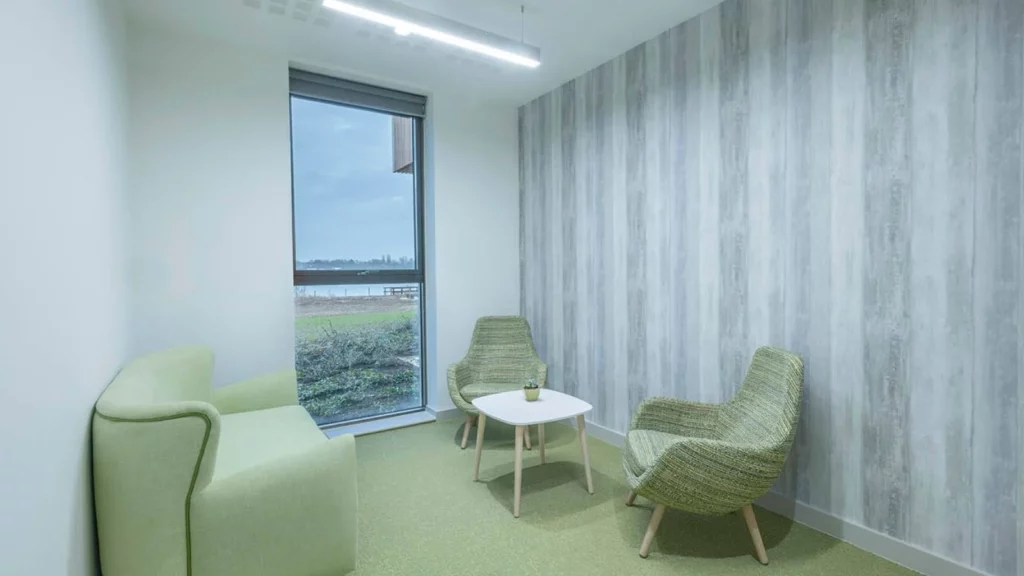The Role of Biophilic Design in Care Facilities
Posted on 20 January 2025 By Lucy Fisher

In This Article
Biophilic design in care environments has become a huge thing, and for good reason. It integrates natural elements into built environments, encouraging improved mental and physical well-being. The approach is gaining momentum in care facilities, where its benefits address critical challenges like stress, isolation, and recovery. By embracing natural light, greenery, nature-inspired materials, and outdoor spaces, care environments can promote healing and create more uplifting spaces for residents and staff. In this blog, we explore the transformative impact of biophilic design, focusing on its benefits and practical applications in care settings.
Letting the Sunshine In: Benefits of Natural Light
Natural light is a cornerstone of biophilic design, offering significant physical and emotional benefits. Care facilities can create environments that promote health and well-being by maximising natural light through features like windows, skylights, and reflective surfaces. Exposure to natural light helps regulate circadian rhythms, leading to improved sleep patterns and overall health. Additionally, sunlight is a natural mood booster, reducing symptoms of depression and improving overall mood for residents and staff alike. Thoughtfully designed spaces, such as patient rooms with large windows that offer scenic views and light wells in shared areas, ensure that natural light reaches deeper into interiors, enhancing the atmosphere for residents and staff alike.
You can incorporate practical biophilic design strategies in care environments to make the most of natural light. Light-diffusing materials are effective in minimising glare while maintaining brightness, helping to create a comfortable and inviting environment. Smart blinds can be integrated to balance light levels and control indoor temperatures, ensuring year-round comfort. By prioritising these elements, care facilities can harness the therapeutic power of sunlight to improve the quality of life for everyone who uses the space.
Bringing the Outdoors Indoors: Incorporating Greenery
Adding greenery to care facilities bridges the gap between indoor and outdoor environments, creating calming and healthful spaces. Greenery plays a vital role in biophilic design, offering both environmental and emotional benefits. Indoor plants naturally improve air quality by filtering airborne pollutants, contributing to a healthier environment for residents and staff.
Beyond their functional advantages, greenery creates a calming atmosphere, reducing stress and enhancing overall well-being. Thoughtful applications of greenery (like vertical gardens in communal areas that serve as living art pieces or potted plants in private rooms that add a personal touch) help integrate the soothing presence of nature into everyday spaces.
To maximise the benefits of indoor greenery, it’s essential to select low-maintenance, non-toxic plants that thrive in indoor conditions. For easier upkeep, planters with built-in irrigation systems can ensure consistent watering and reduce the burden on care staff. These practical design choices not only enhance the visual appeal of care facilities, but also create an environment that supports health, relaxation, and connection to the natural world.

Designing with the Earth in Mind: Nature-Inspired Materials and Textures
Use the Earth as your inspiration – integrating natural materials such as wood and stone into care facility design creates a comforting connection to the outdoors. These materials bring warmth and character to otherwise sterile spaces, making them feel more inviting and homelike. Additionally, textured surfaces encourage tactile engagement, which can be especially beneficial for residents in dementia care by stimulating sensory interaction and providing a grounding experience. Examples include incorporating wooden furniture and accents in patient lounges to create a cosy atmosphere, or using stone-textured walls and countertops to add elegance and durability to shared areas.
When choosing natural materials for biophilic design in care facilities, practicality and safety are key considerations. Slip-resistant stone flooring promotes safety while maintaining an organic aesthetic, making it suitable for busy areas of footfall.
Similarly, selecting durable, easy-to-clean materials ensures long-term usability and reduces maintenance demands. By thoughtfully incorporating these elements, care facilities can balance functionality with the aesthetic and emotional benefits of nature-inspired design.
The Therapeutic Power of Fresh Air: Outdoor Spaces for Healing
Accessible outdoor spaces are a vital aspect of biophilic design in care environments, offering residents opportunities for relaxation, recreation, and recovery. These spaces encourage physical activity through gentle exercises like walking, which can be facilitated by well-designed gardens and pathways.
Shared outdoor areas also encourage social interaction, helping to build a sense of community and reducing feelings of isolation among residents. The connection to nature provided by these spaces is also a proven stress reliever, promoting overall mental and emotional well-being.
To create truly inclusive and functional outdoor spaces, thoughtful design is essential. Sensory gardens with fragrant plants and textured paths engage multiple senses, providing therapeutic benefits for residents. Rooftop terraces can offer mobility-impaired individuals access to fresh air and greenery, ensuring everyone can enjoy the outdoors. Key design considerations include ensuring pathways and seating are accessible for all users and incorporating shaded areas to make these spaces comfortable throughout the year. By prioritising accessibility and comfort, care facilities can make the most of the benefits of outdoor environments.
Conclusion
Biophilic design offers a transformative approach to care facilities, enhancing natural light, incorporating greenery, using nature-inspired materials, and creating healing outdoor spaces. These elements improve patient outcomes, staff satisfaction, and overall facility appeal. By embracing biophilic principles, care facilities can create environments that support and encourage healing and well-being.
So how can you incorporate biophilic design in your work? Follow our tips above and contact our team for expert guidance and tailored solutions. Explore our resources and get in touch to discover the full potential of biophilic design in care environments.
Speak to The Experts
Need assistance with product enquiries, general inquiries, or product support? Our Phonelines are open 9am - 5pm Monday to Friday
0113 519 0319
Or, fill out the form for a call back.
